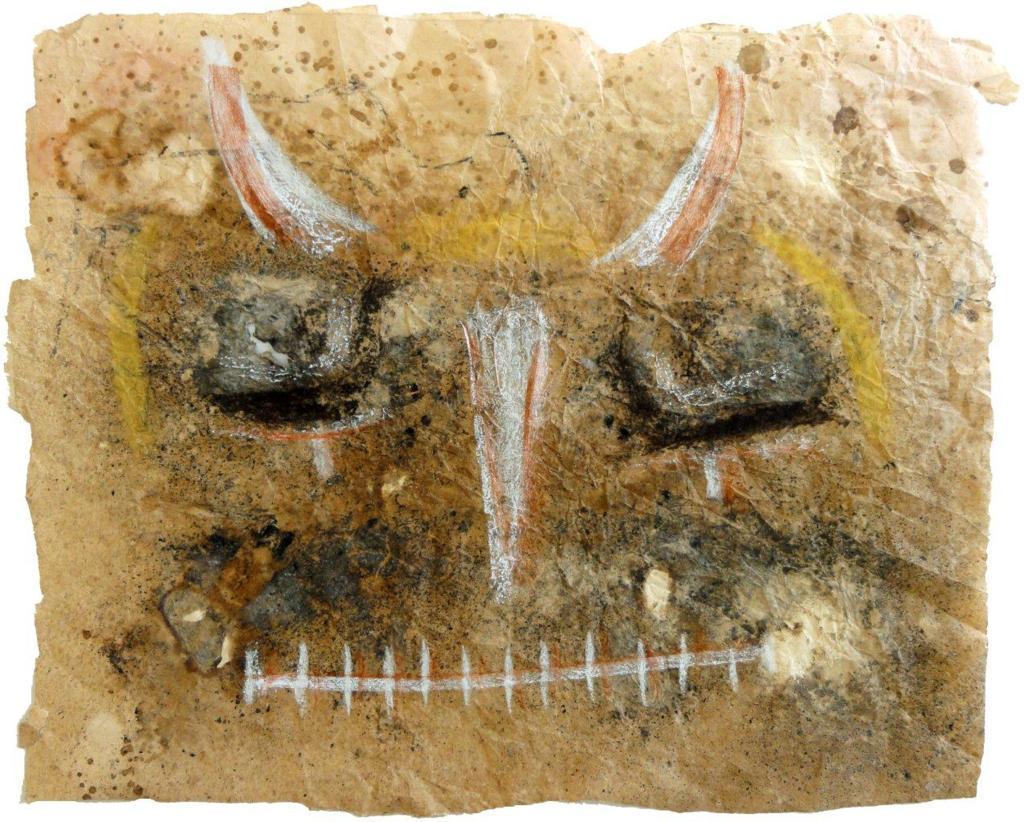This is similar to the first avant-garde works produced at the end of the nineteenth and the beginning of the twentieth century: first of all, the works of Symbolism, anti-classical, anti-naturalistic, anti-modern currents: for example, the solution of Gauguin and the Pont-Aven School, that proposed the à plat technique, the compact and synthetic application of paint within the confines of up to the surface of the picture plane. But let us go back in time: while often in the Hellenistic Greek period the placement of figures was irrelevant, also in medieval painting we find “flat decoration”; scenes that are iconographically untidy, images and symbols placed randomly, often clumped together in bunches without background - flattened and lacking any spatial references of depth - using types of expression that we immediately connect to a period five centuries later - in the second half of the nineteenth century - and apparent in the artistic tendencies that separate the false from the authentic, abandonment of phenomenalism and realism with a wealth of representational detail in favor of a reduced and simplified symbolism.
It is first through symbolist painting and later the trend toward an stylization the second avant-garde movement (Pop Art) that we can capture a direct connection to contemporary art, and specifically to the works of Benetti. The artist has fully understood that we live in a period in which the center is everywhere and there is no need to define your position using a strict set of gridlines that represent the various forms of reality: computer systems and recent technological achievements have accustomed us to erratic movement in time and space, where we travel in jump cuts and fits and starts from one place to another, from one historical period to another without flinching, cancelling all kinds of distances, even cultural distance. We are skilled in poking through space in order to find intercepting forms and symbols that wander through ambiguous dimensions, and then we classify them and line them up in a sort of cartography of a new world. Benetti fits perfectly into this new way of doing things.
His paintings contain ambiguous figures, which bring to mind shapes of objects and utensils that are suspended between an archaic past that implodes all the way back to the origins of human expression, and alludes to a hyper-technological future: the myriad patterns repeated in bright colors - cars, planes, men, animals, everyday objects, etc. - become “intentional forms”, schemes or models of a world seen through a synthesizing lens, where things and people are transformed into almost heraldic symbols, and position themselves in constantly changing compositional rhythms. So we encounter each figure’s outline, that single line that has come back into use among wallpainter and street artists, but that we can easily compare to the practice of cloisonne so dear to the Symbolists: the effect this produces is indeed an analogy, that is, it gives form to an idea, to an intention that is not naturalistic but can be interpreted through principles and habits of imagery that have entered into the current repertoire of skills for discerning the visible - made up of icons, symbols, synthesized images that with a few strokes say a great deal, just like signage, advertising, media communications and especially the visual language used in the digital world.
Today, most people are perfectly capable of deciphering the many and varied meanings of icons on a computer desktop or in the most common software programs. The speed at which information travels these days has once again (like in the ancient and pre-modern periods) has habituated us to letting our brains fill in the blanks where description and explanation are lacking; communication flies by, throwing information at us at an ever more frenetic rate, unimaginable just ten years ago. And this has fine-tuned our noetic abilities to find more or less explicit meaning in the conciseness of the imagery that surrounds us. That is why the clear and bold outlines and the flat chromatic coloring of Benetti’s painting - as opposed to the shading and illusory effects used to show depth in realistic painting - define space, while at the same time make the figures emerge from the background lending a sort of stereometric (volumetric) aspect to the shapes. And this mutates into a veritable new linguistic code that can give us a well-defined perceptive recognition.
No wonder Benetti uses stencils or patterns, so fashionable among young artists, and connected to medieval art, and anti-naturalistic by definition like the latest currents in painting. Using a pattern, or stencil requires you to study reality and choose the essential communicative and expressive elements in order to re-propose reality through a filter, freed of its descriptive elements. Andrea Benetti applies a healthy, and I dare say, “ecologically” expressive reductionism, which seems contrary to the invasiveness of imagery that which is now reaching paroxysmal levels, inviting us to meditate not only on the “differing repetitions” of reality but also on those serializing mechanisms that lie at the base of every object we produce, be they material or cultural.
But his return pathway to the origins of art history and cultural anthropology does not stop at mere pictorial representation: Benetti goes beyond and changes the game rules. Besides icons and symbols, he reclaims a vast repertoire of oral communication, sounds, noises, sung and spoken but unwritten words, that were so precious to the premodern art and have now regained their impact through modern technology. All this provides a synergy between image and sound that began historically in the avant-garde, Futurist and e Dadaist periods. Furthermore, in the 1960’s, Marshall McLuhan, in The Medium is the Massage (1967), coined the notions of “visible space” and “acoustic space” and theorized humanity going back to the primordial sensorial system, rife with emotion and synesthetic ability with the help of electronic media. Today, this Canadian academic’s thought seems to have been confirmed: we are literally immersed in a dynamic and interactive dimension. Perceived space is characterized not only by visible stimuli, but also by sound, in its various oral, musical, and noise modulations, like those created and interpreted by Frank Nemola during the inauguration of this exhibition.
We seem to have come full circle with “Colors and Sounds from the Origins”: The return to that primordial sensoriality McLuhan predicted more than 40 years ago comes to life with Nemola’s improvisation and Benetti’s icons and colors. This atmosphere they evoke is a “normalized” situation, as a matter of fact, where the combination of imagery and sound has an avant-garde flavor to it, in primis futuristic, but wielding a completely contemporary impact. The sound experience that Nemola has created specifically for this project is not necessarily tied down to a predetermined score. It helps participants immerse themselves in the action, as they are projected into a novel space and time dimension. Participants are not passive additions to a sound performance environment as simple spectators. On the contrary, they play an integral part in the “advanced musical gesture” Nemola proposes.
Silvia Grandi
Professor and researcher in Contemporary Art Phenomenology
DAR – (Dept. Of Visual, Performance and Media Arts)
Università degli Studi di Bologna








Comments 1
Say something